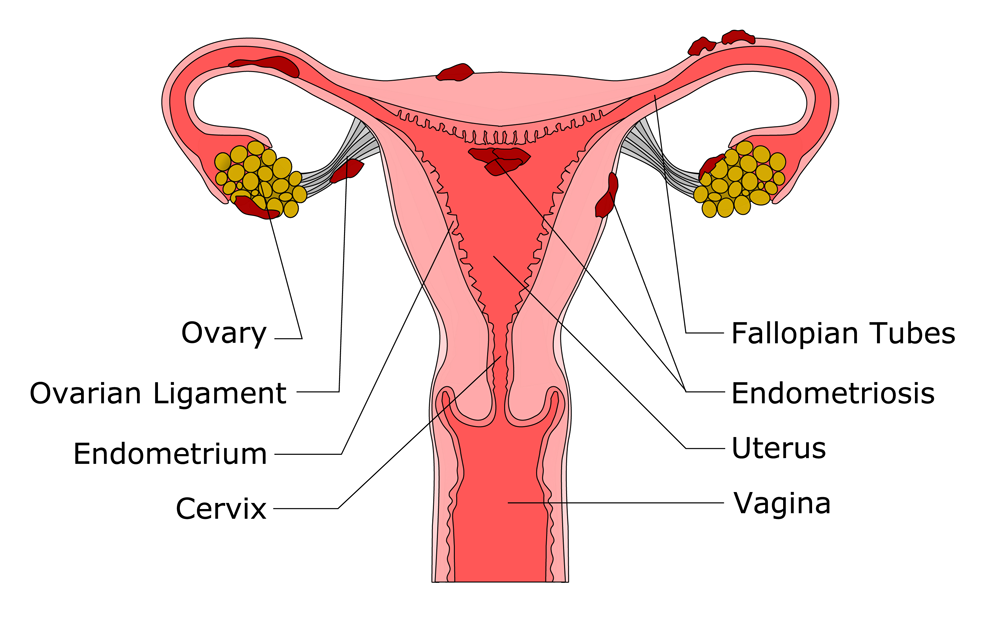
In the shadows of society’s awareness, an untold army of women struggle with the uncertainty of endometriosis.
This silent pain affects millions, yet its reality remains largely misunderstood and overlooked.
Endometriosis happens when the tissue similar to the tissue that lines your uterus grows outside of the uterus.
This tissue acts as regular uterine tissue does during your period breaks apart and bleeds at the end cycle. But this blood has nowhere to go. Surrounding areas may become inflamed or swollen.
According to a certain medical report, endometriosis is the leading cause of infertility. Nearly 2 of every 5 people who cannot get pregnant have it.
If endometriosis interferes with your reproductive organs, your ability to get pregnant can become an issue.
- When endometrial tissue envelops your ovaries, it may hinder the release of eggs.
2. Endometrial tissue can obstruct the passage of sperm through your fallopian tubes.
3. This tissue has the potential to impede the descent of a fertilized egg through your tubes to your uterus.
Despite surgical intervention being able to address certain issues, endometriosis can still present challenges for conception through other means;
- It can change your body’s hormonal chemistry.
2. It can cause your body’s immune system to attack the embryo.
3. It can affect the layer of tissue lining your uterus where the egg implants itself.
Surgical removal of endometrial tissue by your doctor can create a clear path for sperm to fertilize the egg.
If surgery isn’t feasible, intrauterine insemination (IUI) could be an alternative, involving the direct placement of your partner’s sperm into your uterus.
Your doctor might recommend combining IUI with “controlled ovarian hyperstimulation,” utilizing medication to stimulate your ovaries to produce more eggs, increasing the likelihood of conception compared to those not using this technique.
In vitro fertilization (IVF) presents another option, potentially enhancing your chances of conceiving, although success rates can vary among IVF pregnancies.
There are 4 types of endometriosis;
Superficial peritoneal endometriosis. In this type of endometriosis, the endometrial tissue attaches to the peritoneum, a thin membrane lining the abdomen and pelvis, as well as covering most organs within. This form is considered the least severe.
Endometriomas. Also known as chocolate cysts, these are fluid-filled cysts that are dark in color. They can vary in size and may appear in various parts of the pelvis or abdomen, with the ovaries being the most common location.
Deeply Infiltrating endometriosis (DIE). In this type, endometrial tissue invades organs within or outside the pelvic cavity, such as the ovaries, rectum, bladder, and bowels. In rare cases, extensive scar tissue can cause organs to become stuck in place, a condition known as a frozen pelvis. However, this complication occurs in only 1%-5% of people with endometriosis.
Abdominal wall endometriosis. Sometimes, endometrial tissue can grow on the abdominal wall and attach to surgical incisions, such as those from a C-section.
You might not notice any signs of endometriosis. When you have them they include;
Experience back pain during your period
Struggling with severe menstrual cramps
Feeling pain while pooping or peeing, especially during your period
unusual or heavy bleeding during your periods
Notice blood in your stool or urine
Dealing with diarrhea or constipation
Experiencing painful sex
Suffering from persistent fatigue
Having trouble getting pregnant
Symptoms don’t always correlate with the severity of endometriosis. You may have significant extra tissue with no symptoms, or a small amount that causes considerable symptoms.
The exact cause of endometriosis remains unclear to doctors. Some experts speculate that menstrual blood containing endometrial cells may flow backward through your fallopian tubes into your pelvic cavity, where the cells adhere to your organs—a phenomenon known as retrograde menstruation.
Additionally, genetics may contribute to its development; if your mother or sister has endometriosis, you’re at a higher risk of getting it, with research indicating a tendency for it to worsen from one generation to the next.

